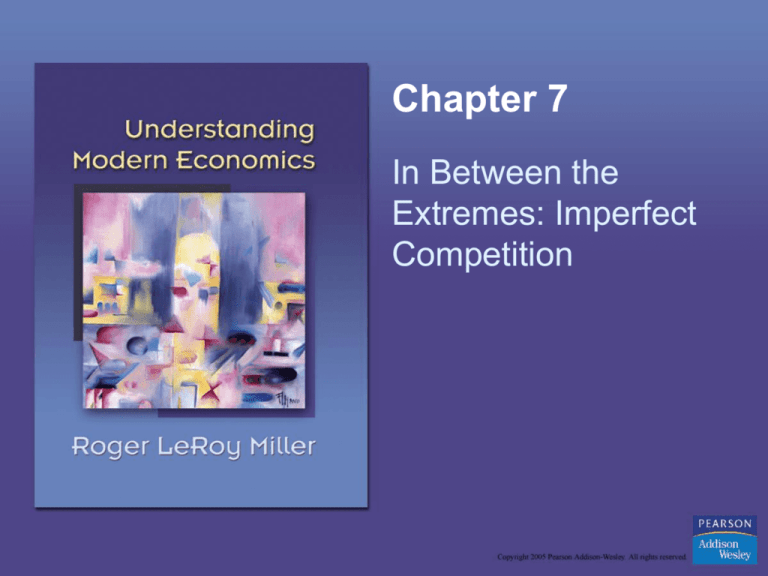
Chapter 7
In Between the
Extremes: Imperfect
Competition
Learning Objectives
• List the five conditions that must be met for the
existence of monopolistic competition.
• Describe the methods that firms can use to signal to
consumers that their products are of high quality.
• List the four characteristics of oligopoly.
• Explain opportunistic behavior and why most firms
(and consumers) do not engage in it consistently.
• Describe one form of tacit collusion among firms in
an oligopolistic industry.
Copyright © 2005 Pearson Addison-Wesley. All rights reserved.
7-2
Monopolistic Competition
• The most common form of market
structure in the United States is
monopolistic competition, in which a
large number of sellers offer similar, but
slightly differentiated products.
• Examples of monopolistically
competitive industries are brand-name
items such as toothpaste, cosmetics,
and designer clothes.
Copyright © 2005 Pearson Addison-Wesley. All rights reserved.
7-3
Characteristics of Monopolistic
Competition
1. Numerous Sellers
2. Relatively Easy Entry: Entry into the
market is easier than in an industry
with just a few dominant firms.
3. Differentiated Products: Each
supplier sells a slightly different
product to attract customers.
Copyright © 2005 Pearson Addison-Wesley. All rights reserved.
7-4
Characteristics of Monopolistic
Competition (cont.)
4. Non-price Competition: Businesses
compete, at least in part, by using
product differentiation and by
advertising.
5. Some Control Over Price: By
building a loyal customer base through
product differentiation, each firm has
some control over the price it charges.
Copyright © 2005 Pearson Addison-Wesley. All rights reserved.
7-5
Comparing Demand Curves
• The demand curve facing a perfect
competitor is perfectly elastic.
• The demand curve facing a monopolist
is the entire market demand curve.
• The demand curve facing a firm in a
monopolistically competitive industry
is somewhere in between the two
extremes.
Copyright © 2005 Pearson Addison-Wesley. All rights reserved.
7-6
Figure 7-1: Comparing Demand
Curves
Copyright © 2005 Pearson Addison-Wesley. All rights reserved.
7-7
The Long Run for the
Monopolistically Competitive Firm
• In the long run, because so many firms
produce substitutes for the product in
question, any economic profits will
disappear through competition.
• In the long run, the price that firm can
charge will just equal its average total
cost. It will be making a normal rate of
return and zero economic profits.
Copyright © 2005 Pearson Addison-Wesley. All rights reserved.
7-8
Figure 7-2(a): Comparison of the Perfect
Competitor with the Monopolistic
Competitor
Copyright © 2005 Pearson Addison-Wesley. All rights reserved.
7-9
Figure 7-2(b): Comparison of the Perfect
Competitor with the Monopolistic
Competitor (cont.)
Copyright © 2005 Pearson Addison-Wesley. All rights reserved.
7-10
Monopolistic Competition
May Lead to Waste
• It has been argued that monopolistic
competition involves waste because
minimum average total costs are not
achieved and price exceeds marginal
cost.
• There are too many firms, each with
excess capacity, producing too little
output. Therefore, according to critics,
society’s resources are being wasted.
Copyright © 2005 Pearson Addison-Wesley. All rights reserved.
7-11
Sale Promotion and Advertising
• Advertising is used to increase demand
and to differentiate one’s product.
• How much advertising should be
undertaken? It should be carried to the
point at which the additional revenue
resulting from one more dollar of
advertising just equals one dollar.
Copyright © 2005 Pearson Addison-Wesley. All rights reserved.
7-12
Oligopoly
• Is an industry structure consisting of a
small number of interdependent
sellers.
• Each firm in the industry knows that
other firms will react to its changes in
prices, quantities, and qualities.
• An oligopoly market structure can exist
for either a homogeneous or a
differentiated product.
Copyright © 2005 Pearson Addison-Wesley. All rights reserved.
7-13
Characteristics of Oligopoly
1. Few Sellers: Several large firms are
responsible for 60 to 80 percent of the
market.
2. Identical or Slightly Different
Products: The goods and services
provided by oligopolists are very
similar.
Copyright © 2005 Pearson Addison-Wesley. All rights reserved.
7-14
Characteristics of Oligopoly (cont.)
3. Non-price Competition: Advertising
emphasizes minor differences and
attempts to build customer loyalty.
4. Interdependence: Any change in
competitive practices on the part of
one firm will cause a reaction on the
part of other firms in the oligopolistic
industry.
Copyright © 2005 Pearson Addison-Wesley. All rights reserved.
7-15
Industry Concentration
• There is no one way to determine
whether an industry is oligopolistic.
• Economists have chosen industry
concentration ratio statistics in order
to talk about oligopolies.
• Industry concentration ratio—
measures the percentage of total sales
accounted for by the top four firms.
Copyright © 2005 Pearson Addison-Wesley. All rights reserved.
7-16
Figure 7-4: Selected Potential
Oligopolies
Copyright © 2005 Pearson Addison-Wesley. All rights reserved.
7-17
Are Oligopolies Harmful to
Consumers?
• To the extent that oligopolists have market
power, they lead to resource misallocations.
• Oligopolists charge prices that exceed
marginal cost.
• However, if an oligopoly occurs because of
economies of scale, consumers might
actually end up paying lower prices than if the
industry were composed of numerous smaller
firms.
Copyright © 2005 Pearson Addison-Wesley. All rights reserved.
7-18
Duopoly
• It is possible to have only two firms in
one market. This is called a duopoly.
• There are very few duopoly markets in
the world today. When they exist, it is
relatively easy for the two members of
the duopoly to collude on prices and
perhaps market share.
Copyright © 2005 Pearson Addison-Wesley. All rights reserved.
7-19
How to Make Higher Profits
Through Price Discrimination
• An imperfect competitor (including a
monopolist) may be able to charge
different people different prices. When
there is not a cost difference, this
strategy is called price discrimination.
• A firm will engage in price discrimination
whenever feasible to increase profits.
Copyright © 2005 Pearson Addison-Wesley. All rights reserved.
7-20
How to Make Higher Profits
Through Price Discrimination (cont.)
• Profitable price discrimination involves
charging a higher price to customers
who have a relatively low price elasticity
of demand.
• At the same time, customers with high
price elasticity of demand are charged
lower prices.
Copyright © 2005 Pearson Addison-Wesley. All rights reserved.
7-21
Interdependence and Strategic
Dependence
• All markets and all firms are, in a sense,
interdependent.
• Only when a few large firms account for
a majority of sales in an industry does
the question of strategic dependence
of one on the others’ actions arise.
Copyright © 2005 Pearson Addison-Wesley. All rights reserved.
7-22
Interdependence and Strategic
Dependence (cont.)
• The firms must, and do, recognize that
they are interdependent.
• In an oligopolistic market structure, the
managers of firms are like generals in a
war: They must attempt to predict the
reaction of rival firms. This is a
strategic game.
Copyright © 2005 Pearson Addison-Wesley. All rights reserved.
7-23
Opportunistic Behavior and
Cheating
• Oligopolists prefer higher to lower
profits, so you might think they would
want to “cheat”—they might try to fool
their rivals.
• In another context, an oligopolist could
advertise a product with lots of features
at a specific price, knowing that some of
those features do not exist. This is
called opportunistic behavior.
Copyright © 2005 Pearson Addison-Wesley. All rights reserved.
7-24
Results of Opportunistic Behavior
• If all of us engaged in opportunistic behavior
all of the time, the world would be a mess.
• The reality is that this is not the world in which
most of us live. Why not? Because most of
engage in repeat transactions.
• Sellers would like us to keep coming back to
their stores. Each of us would like to keep our
jobs, get promotions, etc.
Copyright © 2005 Pearson Addison-Wesley. All rights reserved.
7-25
Price Leadership and Price Wars
• Most oligopolists do not explicitly
engage in collusion—they don’t have
meetings to get together to split up the
market or fix prices.
• However, oligopolists can figure out
ways to implicitly determine prices
together. This is called tacit collusion.
• One example of this is the model of
price leadership.
Copyright © 2005 Pearson Addison-Wesley. All rights reserved.
7-26
Price Leadership
• In the model of price leadership, the
basic assumption is that there is one
dominant firm. It is usually the biggest
firm.
• The dominant firm sets the price that it
thinks is profit maximizing. Then it
allows other firms to sell all they can at
that price. The dominant firm sells the
remainder.
Copyright © 2005 Pearson Addison-Wesley. All rights reserved.
7-27
Price Wars
• Price leadership may not always work. If the
price leader ends up much better off than the
firms that follow, the followers may choose
not to set prices according to those set by
that dominant firm.
• The result may be a price war—the dominant
firm lowers its prices a little bit, but the other
firms lower theirs even more.
Copyright © 2005 Pearson Addison-Wesley. All rights reserved.
7-28
Key Terms and Concepts
• collusion
• duopoly
• industry
concentration ratio
• monopolistic
competition
• oligopoly
Copyright © 2005 Pearson Addison-Wesley. All rights reserved.
• opportunistic
behavior
• price discrimination
• price leadership
• price war
• strategic
dependence
• tacit collusion
7-29






